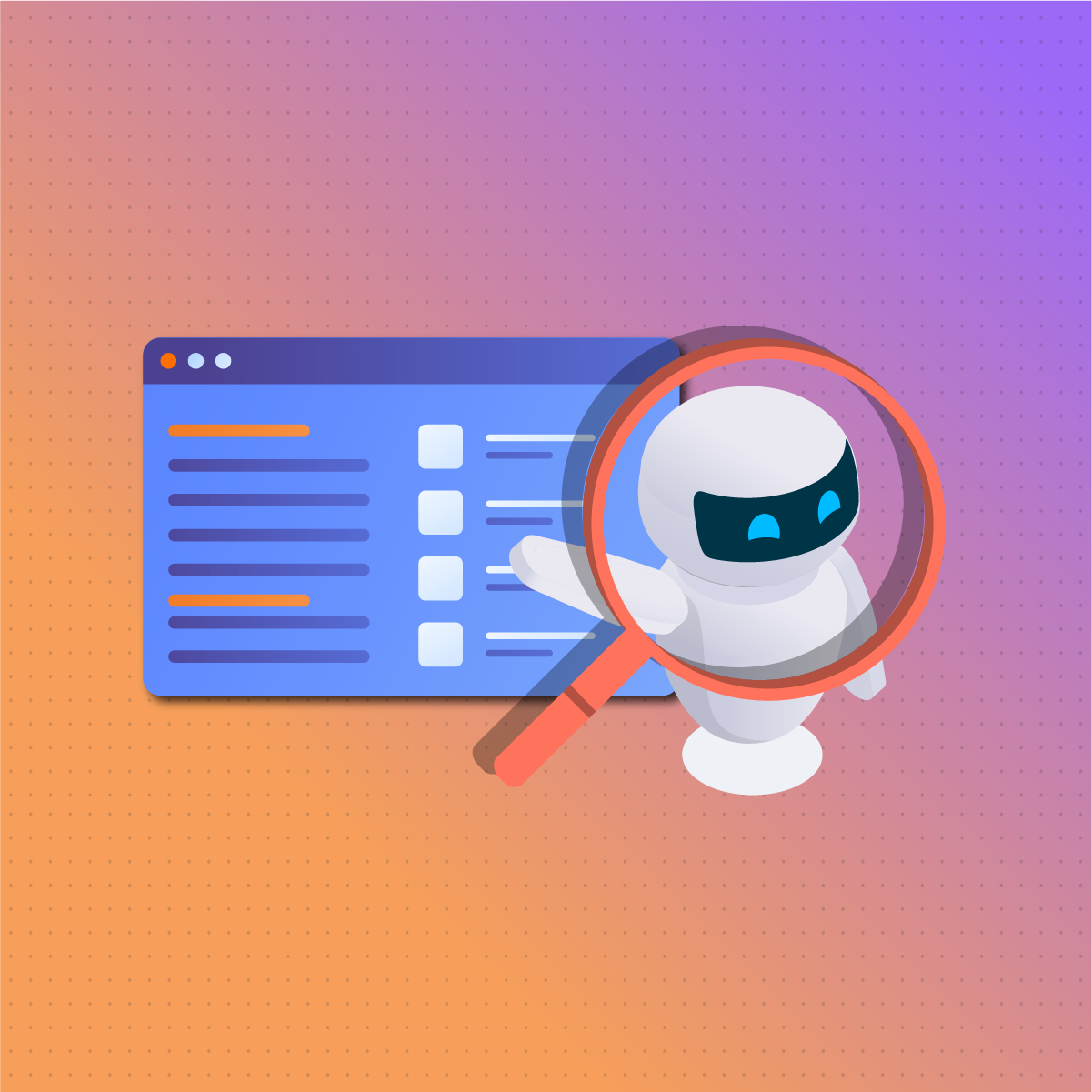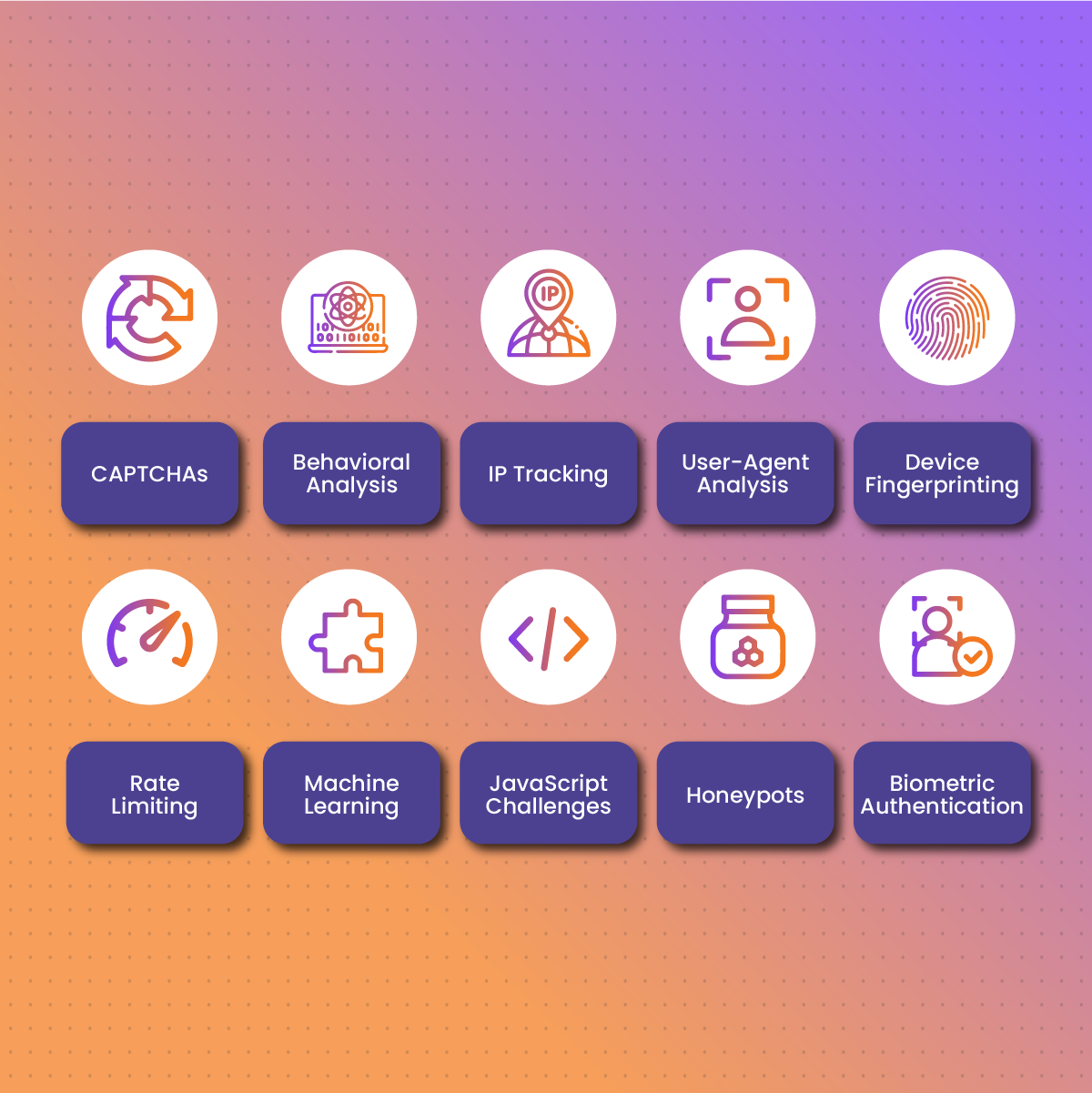Are you aware that your inability to detect bot traffic can pose challenges for your website and overall user experience? Bot traffic is also known for engaging in nefarious activities such as generating fake views, content scraping, and launching security attacks on websites. To overcome this threat, it is crucial to learn how to detect bot traffic yourself.
You must be wondering how. Fear not. We’ve got you covered. In this article, we’ll teach you everything about how to detect bot traffic, including the signs for detection and the different techniques. So buckle up, and let’s begin.
How To Detect Bot Traffic: What Is Bot Traffic?
Bot traffic refers to automated visits to a website or online platform initiated by software programs known as bots or crawlers. These bots can serve various purposes, from beneficial activities like search engine indexing to potentially harmful actions such as click fraud, content scraping, or security attacks.
In website management, understanding how to detect bot traffic is paramount. Recognizing the signs and employing effective detection techniques becomes essential to distinguish between legitimate user engagement and potentially disruptive automated activities, ensuring accurate analytics and improving cybersecurity measures.
How To Detect Bot Traffic: Signs Of Bot Traffic
In learning how to detect bot traffic, it is essential to identify signs of bot traffic. Here are some of the red flags listed below:
Unnatural Traffic Patterns
You need to watch out for sudden spikes in page views, mainly when they occur during off-peak hours or times when user activity is typically low. Bots might take advantage of quieter periods to carry out their activities. Additionally, If there’s a significant increase in traffic from a single source, it’s worth investigating. This can give you an edge on how to detect bot traffic with ease.
Incomplete Form Submissions
In learning how to detect bot traffic, you need to look into incomplete forms. Bots often fill out forms swiftly, lacking the more natural pace of human input. If you see high-speed form submissions, it might be a bot at work. Also, you can check the submitted form data for inconsistencies or patterns. Bots may not follow the expected flow, leading to incomplete or nonsensical information.
Scraping Behavior
Notice a sudden increase in server loads without a corresponding rise in user engagement? Bots could be aggressively scraping your content. Also, they tend to fetch and extract content systematically. Keep an eye on access patterns, especially if it involves rapidly pulling large amounts of data in a short time.
High Bounce Rate And Short Session Durations
In learning how to detect bot traffic, check for a high bounce rate and short session durations, as these are common characteristics of bot behavior. Bots often visit a single page, quickly bounce away, and don’t engage with your site for an extended period. Keep in mind that these bot-induced metrics can distort your overall analytics, making it essential to differentiate between genuine user interactions and automated visits.
Irregular Click Patterns
Get familiar with how to detect bot traffic faster by watching out for repeated clicks in the same spot. Real users tend to click around more naturally. If the timing between clicks seems too perfect or too steady, it might be a sign of automated behavior.
Unrealistic User Behavior
Another way of how to detect bot traffic with ease is to look out for unusual user behavior, such as a lack of mouse movements or unnatural scrolling patterns. Bots often don’t interact with your site in a way that mimics real user engagement.
Uniform User-Agent Strings
Learn how to detect bot traffic with ease by keeping an eye on user-agent strings. If you notice the same or very similar strings repeatedly, it’s a red flag for potential bot activity. Real users have a variety of devices and browsers, leading to a more diverse range of user-agent strings.
Unusual Referrers
Check if the referrer information seems missing or fake. A genuine user would usually have a diverse set of sources leading to your site. Be wary if you notice a limited set of referrers. Bots often stick to a predictable pattern. This can give you more edge on how to detect bot traffic with ease.
Unusual Geographical Patterns
Keep an eye on your website analytics. If you notice a sudden surge in visitors from specific countries or regions, especially if it doesn’t align with your usual audience, it could signal bot activity. Also, check if these visitors are interacting with your site in a meaningful way. Bots may inflate visitor numbers but usually don’t engage like genuine users.
How To Detect Bot Traffic: Impacts Of Bot Traffic To Websites
The impacts of bot traffic on websites can be significant, emphasizing the importance of knowing how to detect bot traffic. Here’s a breakdown:
It Can Lead To SEO Distortion
When you don’t know how to detect bot traffic and stop it, it can cause excessive bot traffic. This can lead to distorted analytics, which can result in inaccurate data that may compromise search engine optimization (SEO) efforts. Search engines rely on genuine user interactions to assess a website’s relevance, and inflated metrics can misrepresent its actual standing.
It Can Cause Bandwidth Drain
Bots consume bandwidth, potentially slowing down website loading times for legitimate users when you don’t know how to detect bot traffic. This can result in a poor user experience and, in some cases, deter visitors from engaging with the site.
It May Result In Resource Overutilization
Your inability to know how to detect bot traffic can cause aggressive or malicious bots to exploit server resources. This can cause overutilization, which can lead to website downtime or slowdowns.
It Can Cause Content Scraping
If you need help understanding how to detect bot traffic, bots may scrape and replicate your website content, affecting originality and potentially leading to intellectual property concerns. This can also impact a site’s search engine rankings.
It Can Result In Fraudulent Activities
Some bots engage in fraudulent activities like click fraud in online advertising, especially when you’re unsure how to detect bot traffic. This can lead to wasted advertising budgets and undermine the effectiveness of online marketing efforts.
It Can Lead To Security Risks
Malicious bots pose a security threat by attempting to exploit vulnerabilities in a website’s infrastructure. Discovering and implementing effective strategies on how to detect traffic bot activities is crucial for safeguarding against potential risks, such as probing for weaknesses, attempting unauthorized access, or initiating cyber attacks.
Hence, as a website owner, learning how to detect bot traffic can help you mitigate these challenges, ensuring a more secure, reliable, and accurate online presence. Let’s move to the benefits of Bot traffic.
How To Detect Bot Traffic: Benefits Of Bot Traffic
As we dive into understanding how to detect bot traffic, let’s explore the benefits of bot traffic. They include:
It Boost Search Engine Crawlers
Search engine bots, such as those from Google and Bing, index web pages to improve search results. This kind of bot traffic is beneficial as it enhances a website’s visibility in search engines, ultimately driving organic traffic.
It Is Employed For Performance Monitoring
You can employ bots to monitor website performance and uptime. They can alert website administrators to issues, helping ensure that the site is consistently available and responsive.
It Improves Customer Support Efficiency
Chatbots and automated customer support systems use bot technology to handle routine inquiries, providing quick responses and improving overall customer service efficiency.
It Can Be Used For Data Collection
You can use bots in data gathering and analysis, aiding businesses in understanding user behavior, market trends, and other valuable insights. This data-driven approach can inform strategic decision-making.
It Improves The Efficiency Of Automated Tasks
Bots can automate repetitive tasks, streamline processes, and improve operational efficiency. This is evident in various industries, including finance, healthcare, and e-commerce.
How To Detect Bot Traffic: What Is Bot Detection?
Bot detection refers to the process of identifying and distinguishing automated bots or scripts from legitimate human users accessing a website or online platform. The objective of learning how to detect bots is to recognize and filter out bot traffic. This will help to ensure the integrity of user analytics, maintain the performance of the website, and enhance security. To understand how to detect bot traffic further, let’s look at the importance of bot detection.
How To Detect Bot Traffic: Importance Of Bot Detection
As one of the aspects of our guide on how to detect bot traffic, bot detection is essential.
Protecting Analytics
Bots can artificially inflate website traffic metrics, leading to inaccurate analytics. When you know how to detect bot traffic as a website owner, you can obtain more reliable data for performance analysis and decision-making.
Maintaining Server Resources
Bots can consume server resources, causing slowdowns or even crashes. Knowing how to detect bot traffic effectively helps prevent resource overutilization, ensuring a smoother experience for legitimate users.
Enhancing Security
Malicious bots may attempt to exploit vulnerabilities, engage in cyber attacks, or compromise sensitive information. Knowing how to detect bot traffic plays a crucial role in mitigating potential security threats.
Improving User Experience
Bots can negatively impact user experience by creating artificial traffic, contributing to slower page loads, and affecting website responsiveness. Understanding how to detect bot traffic helps in maintaining a positive and efficient user experience.
Preventing Fraud
Specific bots engage in fraudulent activities, such as click fraud in online advertising. Knowing how to detect bot traffic and using the proper tools help identify and mitigate these activities, preserving the integrity of online marketing efforts.
How To Detect Bot Traffic: Bot Detection Techniques 
In understanding how to detect bot traffic, there are several techniques you can use to identify and mitigate automated activities. Some common methods include:
CAPTCHAs
CAPTCHAs often present distorted or warped text that is easy for humans to interpret but difficult for bots to bypass. In applying measures on how to detect bot traffic, some CAPTCHAs use objects in images, adding a layer of complexity for automated programs.
Behavioral Analysis
As an effective strategy on how to detect bot traffic, examining the way users move their mouse on a webpage can reveal patterns that distinguish genuine users from automated bots. Bots may input text more uniformly and rapidly compared to the varied and natural typing patterns of human users.
IP Tracking
Another effective strategy on how to detect bot traffic is to monitor IP addresses of suspicious patterns, such as an unusually high number of requests from a single IP within a short timeframe. Again, cross-referencing IP addresses with geolocation data helps identify discrepancies, especially if traffic is coming from unexpected regions. But keep in mind that these users may use rotating residential proxies at intervals to change their IP addresses.
User-Agent Analysis
The user-agent analysis gives an edge on how to detect bot traffic by checking inconsistencies or anomalies in the user-agent string. This string contains information about the user’s browser and device. However, creating a database of known bot user-agent strings allows for comparison and identification of traffic originating from bots.
Device Fingerprinting
Improving how to detect bot traffic faster is by gathering details like browser type, screen resolution, and operating system; websites create a unique fingerprint for each user. Detecting deviations from the established device fingerprint can signal potential bot activity, as bots may struggle to emulate diverse device characteristics.
Rate Limiting
Request thresholds implement restrictions on the number of requests a user or IP address can make within a specific time frame. Effective rate limiting helps prevent brute-force attacks by slowing down or blocking repeated and rapid attempts.
Machine Learning
Machine learning algorithms analyze historical data to identify patterns associated with bot behavior. By continuously learning and adapting, machine learning models can stay ahead of new bot tactics, making them particularly compelling. However, for an effective strategy on how to detect bot traffic, especially those with unusual patterns, use ISP proxies.
JavaScript Challenges
A practical approach to improving how to detect bot traffic with ease is by using JavaScript to introduce challenges that require interaction, such as button clicks or form submissions. This makes it more challenging for bots to automate actions. Requiring JavaScript execution for content to load, ensuring that interactions involve more than just parsing HTML.
Honeypots
Improving how to detect bot traffic with ease is by embedding hidden fields in forms that are invisible to human users but enticing to bots. Legitimate users won’t interact with these hidden fields, allowing websites to detect and take action against submissions from bots.
Biometric Authentication
Biometric measures like fingerprint or facial recognition are used to verify the user’s identity. However, bots struggle to replicate the complex and unique biometric traits associated with human users, adding an extra layer of security. This gives you an edge on how to detect bot traffic with ease.
How To Detect Bot Traffic: Frequently Asked Questions
I Need to Figure Out If I Have Bot Traffic. Are There Any Red Flags I Should Watch Out For?
Absolutely! Bot activities often leave a trail of suspicious clues. Here are some red flags to keep an eye on:
Unnatural Traffic Patterns
Sudden spikes in page views, especia0lly during off-peak hours, or dramatic increases in traffic from a single source can indicate bot activity. This showcases high suspicion and needs a thorough check.
High Bounce Rate And Short Session Durations
Bots often visit a single page, bounce immediately, and have concise session durations. This can skew your average session time and bounce rate metrics. However, this is a keynote on how to detect bot traffic.
Unrealistic User Behavior
Lack of mouse movements, unnatural scrolling patterns, and repetitive form submissions are all signs of how to detect bot traffic easily.
I’ve Identified Bot Traffic On My Website. What Should I Do Now?
Don’t panic! Once you have an understanding of how to detect bot traffic, you can take steps to mitigate its impact and prevent future attacks. Here are a few key strategies:
Block The Bots
Use your chosen tool to block the identified bots from accessing your website. This may involve blocking their IP addresses, user agents, or other identifying information.
Stay Vigilant
Bot attacks are constantly evolving, so it’s essential to stay informed about the latest trends and threats. Regularly monitor your website analytics and keep your bot detection tools up-to-date. For practical strategies on how to detect bot traffic with ease, use static-residential proxies or residential proxies to mimic real residential IP addresses, providing stability.
How To Detect Bot Traffic: Conclusion
In conclusion, our guide on how to detect bot traffic covers essential points to help you understand how to detect bot traffic with ease. To boost productivity, seamlessly integrate NetNut proxies with your anti-phishing tools and platforms. Experience unparalleled control and insights through our user-friendly dashboard designed to meet your requirements. Feel free to explore our blog for more information or inquire about mobile proxies and other personalized proxy services.








